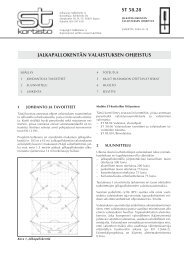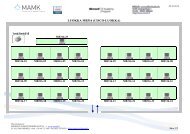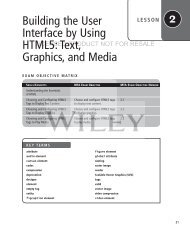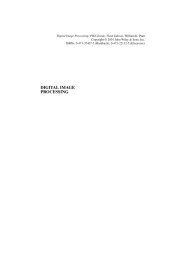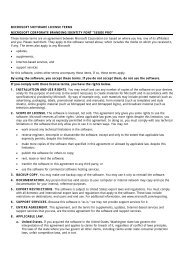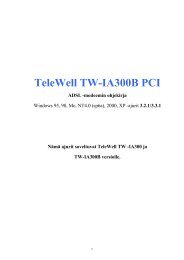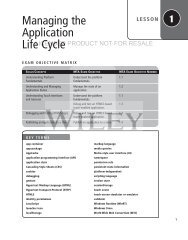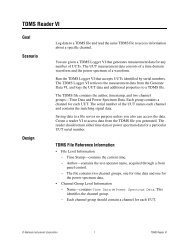Building the User Interface by Using HTML5: Organization ... - server
Building the User Interface by Using HTML5: Organization ... - server
Building the User Interface by Using HTML5: Organization ... - server
Create successful ePaper yourself
Turn your PDF publications into a flip-book with our unique Google optimized e-Paper software.
74 | Lesson 3<br />
Table 3-4<br />
continued<br />
CERTIFICATION READY<br />
Which <strong>HTML5</strong>-specific<br />
attributes do you use for<br />
restricting form input?<br />
2.5<br />
ATTRIBUTE VALUE DESCRIPTION<br />
method get Specifies <strong>the</strong> HTTP (transmission) method<br />
post<br />
used when sending form data; use “get”<br />
for retrieving data and use “post” for<br />
storing or updating data or sending email<br />
LICENSED PRODUCT NOT FOR RESALE<br />
name text Specifies <strong>the</strong> name of a form, which is used<br />
to reference form data after a form is<br />
submitted<br />
novalidate** novalidate A Boolean attribute that specifies that <strong>the</strong><br />
form data (user input) should not be validated<br />
when submitted; <strong>HTML5</strong> also allows<br />
Boolean attributes to be set <strong>by</strong> mentioning<br />
<strong>the</strong> attribute without an equals sign or<br />
assigned value<br />
target _blank Specifies where to display <strong>the</strong> response<br />
_self<br />
received after submitting <strong>the</strong> form<br />
_parent<br />
_blank loads <strong>the</strong> response in a new,<br />
_top<br />
unnamed browser window<br />
_self loads <strong>the</strong> response in <strong>the</strong> current<br />
window; this is <strong>the</strong> default, so it’s use<br />
isn’t required<br />
_parent loads <strong>the</strong> response in <strong>the</strong> parent<br />
window (<strong>the</strong> browser window that opens<br />
<strong>the</strong> form window)<br />
_top loads <strong>the</strong> response in <strong>the</strong> full<br />
browser window<br />
**New in <strong>HTML5</strong>.<br />
<strong>HTML5</strong> introduces numerous input element attributes. The attributes for <strong>the</strong> input element<br />
are listed in Table 3-5; new attributes in <strong>HTML5</strong> are indicated <strong>by</strong> a double asterisk.<br />
Table 3-5<br />
Input element attributes used<br />
in <strong>HTML5</strong><br />
ATTRIBUTE VALUE DESCRIPTION<br />
accept audio/* Specifies file types <strong>the</strong> <strong>server</strong> accepts; used<br />
video/*<br />
only for type="file"<br />
image/*<br />
MIME_type<br />
alt text Specifies alternate text for images; used only<br />
for type="image"; commonly used when<br />
creating a custom Submit button from your<br />
own image file<br />
autocomplete** on Specifies whe<strong>the</strong>r autocomplete is on or off<br />
off<br />
in a form or input field; can be “on” for<br />
specific input fields and “off” for <strong>the</strong> form,<br />
or vice versa<br />
(continued)



